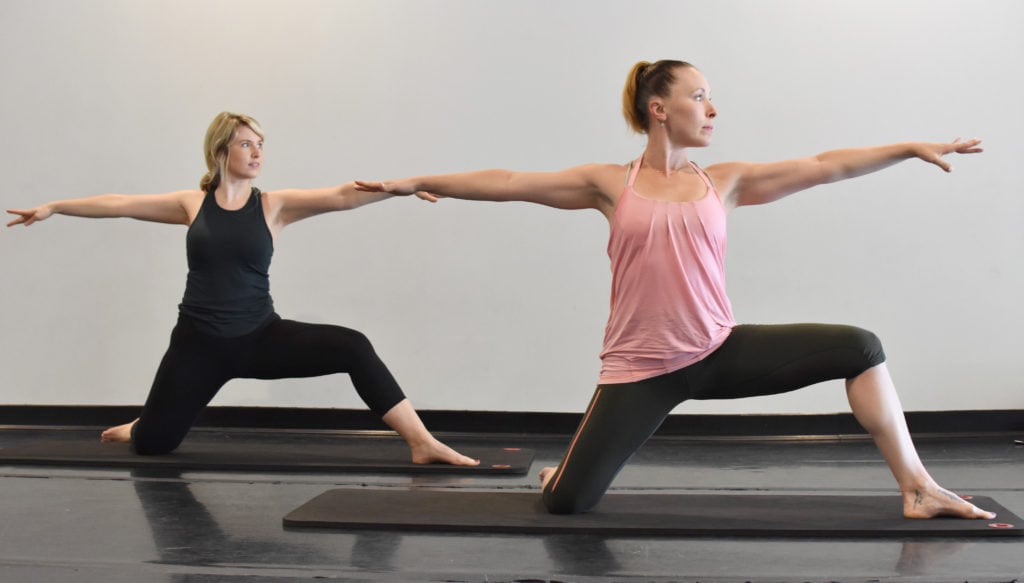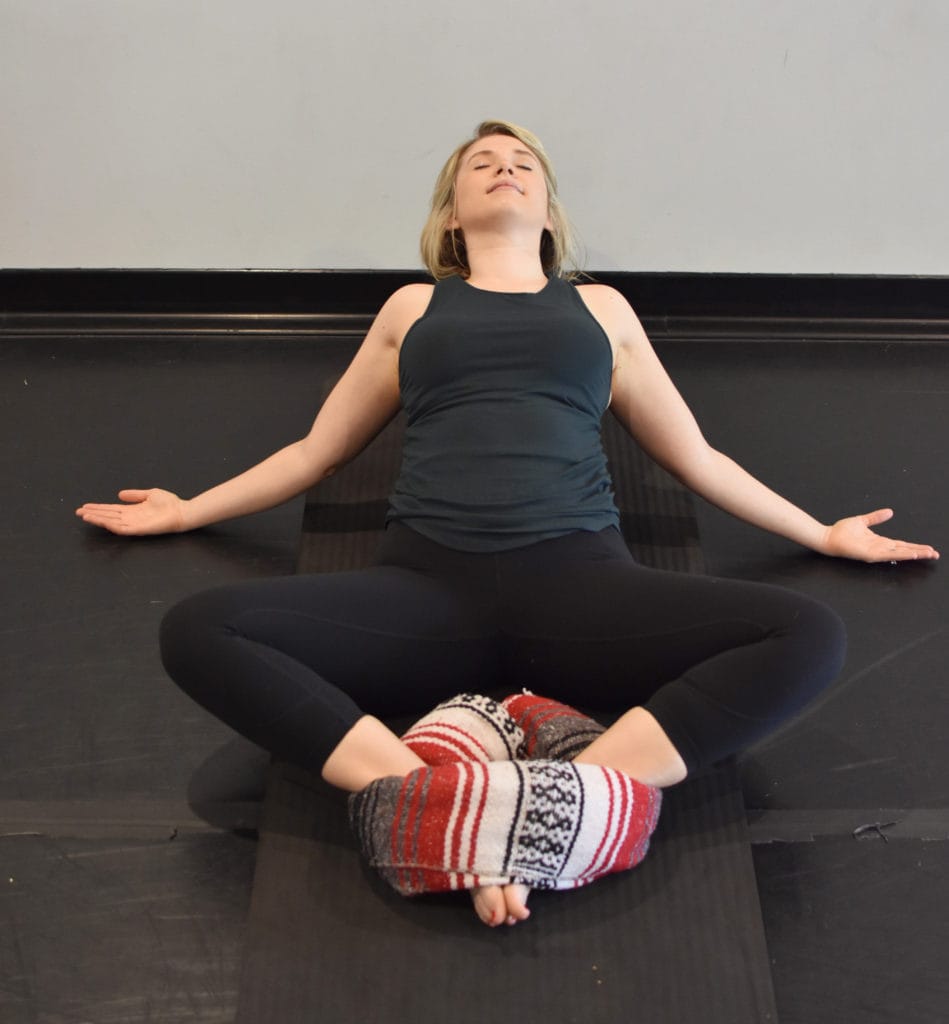For those who have vestibular disorders, simply walking around can be an incredible challenge. We know that our bodies need movement, so our brains can learn to compensate for the damage done to our vestibular system. But how does one move when they feel so sick? This is how yoga for vestibular disorders can help.
Yoga for Vestibular Disorders
Around the beginning of my vestibular migraine, I kept trying to keep myself “grounded” with yoga. Instead, I found that it made me feel more sick than when I first walked in the class. All the bending over and quickly returning to an upright, standing position was enough to trigger a vertigo episode, and I would be miserable the rest of class.
Restorative Yoga for Vestibular Migraine
Instead I avoided doing yoga for a long time, just chalking it up to another thing I would not be able to do again. It wasn’t until several of the women at my ballet studio talked me into trying the restorative yoga class that I decided to give it another chance. They classified it as “adult nap time”, which I was convinced I’d be really good at. Restorative yoga is completely different from a flow yoga class. It’s a much slower pace that emphasizes holding stretches for long periods of time, in addition to meditation and breathing. The meditative, deep stretches really allow you to turn off your brain and focus on yourself. Although my muscles benefitted from the stretch, it’s really my brain that gets the work out. Shutting yourself off from extra thoughts and feelings to clear your mind is freaking hard. But the act of doing restorative yoga is incredibly healing and, as with most exercise, the more you do it the better you get.
I found the mindfulness part to be particularly helpful with my vestibular migraine attacks. Many times we have anxiety creep in, but focusing on our breath and poses that help distract our minds from thinking about symptoms can be helpful.
Props for Restorative Yoga
A major key to restorative yoga is using props to aid you in your stretches. You want to feel the stretch, but not any major discomfort. The props allow you to be supported and relax into the stretch. Some basic props for restorative are:
- Yoga Mat - I've linked an extra thick one which can not only be more comfortable, but can also provide an extra vestibular exercise just by trying to balance on it. If you prefer a thin mat that's non-slip, this will be a better option.
- Bolster
- Blocks
- Yoga Strap
- Blanket
If you don’t want to invest in everything right now, I would suggest starting with a bolster and blocks first. You can easily use a blanket from around the house.
Basic Positions in Yoga for Vestibular Disorders

We’ll start with a basic stretch for your legs - a standing forward fold. What I want to show you here is that if bending over causes you a lot of trouble, like myself, you can use the blocks to support you. You can start with your feet parallel. Then by crossing one leg behind the other at the ankles, you’ll feel the stretch into your IT band. If you have knee issues like I do, this is a great one for you. By parting the legs wider, you can get a deeper stretch through the hamstrings. If you’re feeling balanced and want to take the stretch a little further you can cross your foot over the opposite knee, while folding at the hips. Use your blocks for support. You'll see here I don't put my head down as this can be helpful for those doing yoga for vestibular disorders. I find not lowering my head makes me less dizzy during this stretch.
Quad/Hip Stretch

One of my favorite exercises that’s helped with my balance is a kneeling quad and hip flexor stretch.
- You start by kneeling on the ground and place blocks on both sides of you for support. Then extend one leg in front of you at a 90 degree angle.
- Tuck your pelvis under you so you feel a stretch down the front of your kneeling leg.
- If you’re feeling balanced, reach both hands in opposite directions, stretching as much as you can.
- You can place your hand on the blocks to deepen the stretch to the side, or to support yourself.
Surfing Warrior - A Balancing Pose


From this position you can move into “surfing warrior”, which is as fun as it sounds.
- Extend your left leg to the side, keeping your hip and foot open to the front.
- Your back leg, which is supporting you, will move slightly further in the opposite direction at an angle.
- From this position, lean into your left leg (making sure your knee doesn’t extend past your toes) and extend your arms in opposite directions.
- Hold this position and feel the balance.
For those with vestibular disorders or poor balance, I find this version of warrior to be a lot safer than the standing versions. You’re already close to the ground, so if you need to catch yourself, it’s not far to go. You can also set the blocks on either side of you for support.
Yoga for Migraine
Legs Up the Wall Pose


Legs up the wall pose (yes, it’s such a creative name!) feels wonderful after a workout. Since I had knee surgery last year, it feels great to get a nice stretch without the pressure on my legs. Some with vestibular issues may be triggered by laying down, but I personally find this stretch very relaxing and grounding.
- Roll a blanket to place behind your head for support.
- Start by laying on your side and pressing your butt right up against the wall
- Roll onto your back, while lifting your legs up in the air. Your rear should still be up against the wall
- You can let your legs fall to either side for an inner thigh stretch, or stay supported by wrapping your yoga strap around your legs.
- One way to soothe anxiety and provide comfort is to put a hand over your heart and one over your abdomen. Notice your breath and feel the rise and fall of your hands. You can also try circle breathing where you inhale your biggest breath through the nose, hold for 5 seconds, and exhale fully through the mouth.
- Another comforting position is to place your hands in prayer over your head. At the end of class, Margot will ask us to put our hands to the center of our head for “good thoughts”. I try to carry this with me into the rest of my life as living with an illness tends to lend itself to negative thoughts.


Supported Savasana
At the end of class, you end with savasana, which literally looks like adult nap time. Most classes have you lay flat and quiet, while closing your eyes. I used to find it pretty boring and would let my mind wander, but when my illness was at it’s peak, I found it to be beneficial to push past all the negative thoughts, doctor’s appointments, FMLA, and just clear my mind. I had to literally work to think about nothing.

One thing I learned in my classes with Margot, was you can set up a supported savasana where you’re not laying flat. This is a perfect alternative for those who have their vertigo triggered by lying down. You’ll set up to blocks, one vertical and one horizontal. Then take your bolster and lay it diagonally across both blocks.



Check to make sure it’s stable and then lean yourself back, opening both arms, palms up, out to your sides. You should feel a nice stretch across your chest. If you’d like to add a hip stretch, meet both feet in a butterfly position and wrap a blanket around your ankles to provide support.
For extra relaxation (and one of my favorite parts of class), place a few drops of lavender or frankincense essential oils on your hands and breath them in deeply. Then place your index fingers on your temples and rub the oil in.
Namaste….in this supported savasana instead of cooking right now.

A huge thank you to Margot Martin at The Ballet Burn Dallas for spending her extra time to help with these poses, and Shalie for taking the pictures.





Thank you! You are such a breath of fresh air - your knowledge and support goes far and above. I will definitely try to incorporate many of your ideas, and I love the yoga!
Thanks, Pam, that's really nice to hear. I work really hard at it. 🙂
Thankyou sooo much for this is really a help.
i need.help 3 years of horrible symtoms because of my diagnose of Vestibular migrane!! This is horrible almost every day feeling dizzy!!!!!
Can't wait to buy some restorative yoga props and do this. I've been saving up so seeing these poses explained is what I've been needing.
I wish I could find restorative yoga in West Michigan. I have Fibromyalgia and Chiari brain malformation. Any exercise is so painful.
April, there's a free class on Saturdays online The Ballet Burn. Also Miles for Migraine is doing some classes as well.
I know it’s two years later but I found this page by googling “yoga for vestibular migraines.” Thank you so much - this was wonderful!!
Wait - it’s 3 years!